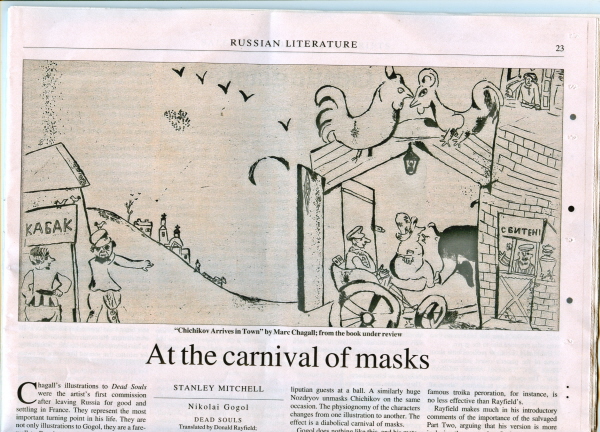 |
Nikolai Gogol DEAD SOULS Translated by
Donald Rayfield; illustrated by Marc Chagall 366pp. Garnett Press. £29.99.
978095358 787 8 Chagall's
illustrations to Dead Souls were the artist's first
commission after leaving This is
the first edition of Dead Souls to include all
Chagall's
illustrations since their original appearance in The
illustrations marked a
new direction for Chagall. With the one exception, an earlier
experiment in
autobiography, he was etching for the first time, searching exuberantly
for new
techniques that ranged from drypoint to aquatint. To quote from Marx in
a
different context: all that is solid melts into air. When Chichikov
visits the
landowner, Manilov, the two men are done in aquatint and look
relatively human.
When they part, their bodies become transparent, as if they are
themselves the
dead souls. Magnitudes vary crazily and the humor is magnificent. A
monstrous
Sobakevich prepares to settle into a diminutive armchair. The clerks in
the
court office are reduced to tiny heads, wielding matchstick pens at
barely
visible desks, or faces floating in a void. A giant condescending
Chichikov
appears before the Lilliputian guests at a ball. A similarly huge
Nozdryov unmasks
Chichikov on the same occasion. The physiognomy of the characters
changes from
one illustration to another. The effect is a diabolical carnival of
masks.
Gogol does nothing like this, and his metaphorical flights are by
comparison
realistic. For this reason, a commentary on the relationship of the
images to
the text would have been welcome. Gogol himself refused any request to
illustrate
his work, commenting that any illustration could only "sweeten" the
novel.
In his short introduction, Donald Rayfield claims that Gogol found in
Chagall
his true illustrator, calling Chagall's imagination "surreal". Yet in
his comments on the novel, Rayfield sides with the nineteenth-century
"realist"
interpretations. Gogol's characters, he suggests, are alive and well in
today's Rayfield
makes much in his
introductory comments of the importance of the salvaged Part Two,
arguing that
his version is mort inclusive than any other. In fact, Christophel
English's
translation (1987) includes both the stories that Rayfield misses in
earlier
translations. More importantly, Rayfield suggest that Part Two
prefigures the
novels of Goncharov, Turgenev, Dostoevsky and Tolstoy. Since Part Two
sets out
on the road of redemption, where we behold a freshly burnished
Chichikov,
accompanied by figures who on the whole are less imaginative than those
in Part
One, we are unlikely to find the future Russian literature germinating
here.
Nor can I imagine Chagall wanting to illustrate Part Two. Nikolai
Dobrolyubov
spotted the only convincing connection between Part Two and later
Russian
fiction in his essay What is Oblomovvism?
(1859-60), where he linked the landowners Tentetnikov and Platonov with
Gonchaarov's hero, Oblomov. But in Part One, Gogol had already
characterized an
idle dreamer in Manilov who is much more perniciously comic than this
pair. The
famous remark often attributed to Dostoevsky that "We all emerged from
Gogol's overcoat" (a reference to Gogol's story of 1842) remains more
accurate. TLS
JULY 10 2009 |
